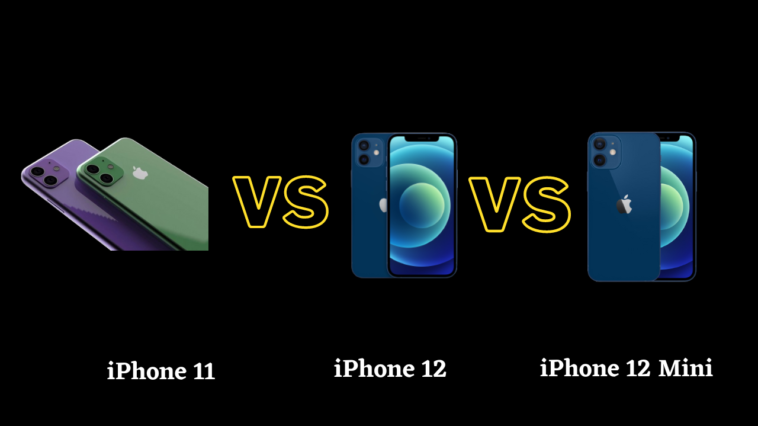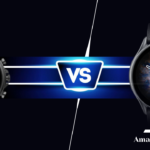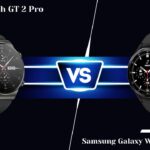Table of Contents
We had no idea that Steve Jobs wasn’t just delivering more of the standard marketing hyperbole when he declared that Apple had “reinvented the phone” and called it the iPhone. Instead, he was thinking about the future. In many ways, the iPhone did change the course of history, and its consequences went beyond the world of cell phones. The notion of mobile gaming was drastically transformed by the iPhone.
Gaming methods changed as a result of the success of products like Angry Birds, which anyone could play with their fingertips on a smartphone. The idea of in-app purchases was developed by the creators as opposed to requiring a sale price. Let’s look at a thorough comparison of the iPhone 11 vs 12 vs 12 Mini.
iPhone 11 Vs iPhone 12 Vs iPhone 12 Mini: Comparison Table
| Features | iPhone 11 | iPhone 12 | iPhone 12 Mini |
| Launching Year | 2019 | 2020 | 2020 |
| Brand | Apple | Apple | Apple |
| Model Name | Apple iPhone 11 | Apple iPhone 12 | Apple iPhone 12 Mini |
| Series | Apple iPhone Series | Apple iPhone Series | Apple iPhone Series |
| OS | iOs | iOs | iOs |
| Design | Apple A13 Bionic | Apple A14 Bionic | Apple A14 Bionic |
| Display | 6.1″ (15.49 cm) | 6.1″ (15.49 cm) | 5.4″ (13.72 cm) |
| Camera | Rear 12 MP + 12 MP Front 12 MP | Rear 12 MP + 12 MP Front 12 MP | Rear 12 MP + 12 MP Front 12 MP |
| RAM | 4 GB RAM | 4 GB RAM | 4 GB RAM |
| Battery | 3110 mAh | 2815 mAh | 2227 mAh |
| Storage | 64 GB | 64 GB | 64 GB |
| Online Pricing Range | ₹ ₹40,990 | ₹48,900 | ₹43,999 |
| Customer Ratings | 4.5/5 | 4.5/5 | 4.5/5 |
READ MORE: Oppo Reno 9 Pro Vs Oppo Reno 8 Pro: Which To Choose And Why?
iPhone 11 Vs iPhone 12 Vs iPhone 12 Mini: Detailed Analysis
Design
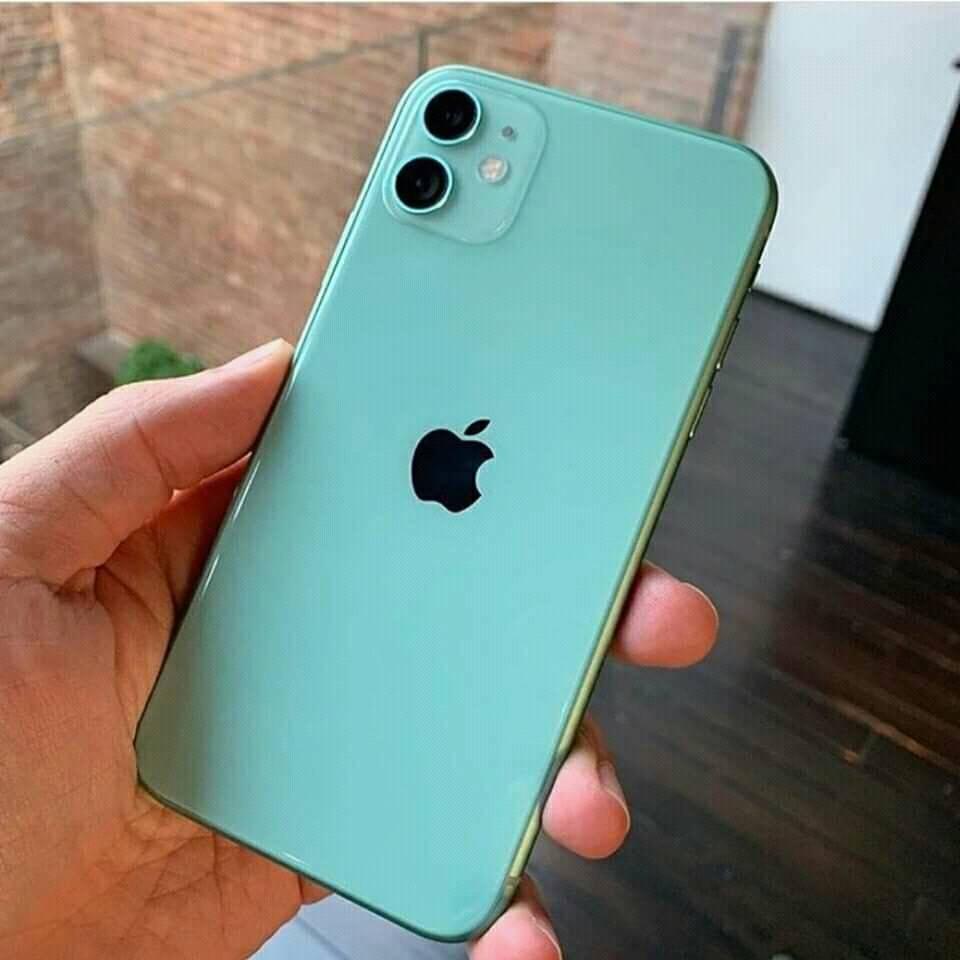
In terms of appearance, the Apple iPhone 11 is almost identical to the iPhone XR, which it replaces. Since both models feature the same notched displays, along with the similar size and weight, it would be difficult to tell the two models apart from the front. However, if you are color-savvy, you can identify the newer design. Like the iPhone XR, the iPhone 11 is available in black, white, yellow, and Product (RED); however, all the colors are reduced. In addition to the blue and coral possibilities of the XR, there is a new green (it’s mint) and a purple (it’s lilac), both of which are more pastel in their approach and attractive as well.
The iPhone 11 boasts a dual camera system housed in a somewhat controversial camera housing, and its aluminum chassis is color-matched to the rear, which is still glass. It also boasts IP68 water and dust protection. Either you’ll adore it or you won’t. We are attached to it, and you will be as well. Compared to many other large, black rectangles on other devices, it is relatively attractive to look at. Although the proud camera housing initially seems to be an add-on, the glass on the back is also strong. Instead, it’s a portion of the same single sheet of glass on the back, with the camera area on the iPhone 11 having a frosted matte finish to further set it apart from the rest of the glossy rear—the opposite of what the iPhone 11 Pro offers.
The iPhone 11 Pro is unmistakably more expensive when placed side by side. Although the Pro models’ matte glass rear and stainless steel chassis are actually lovely in reality, especially in the green and gold hues, you wouldn’t notice them until you were holding them side by side. The iPhone 11 is a beautiful gadget, too. Everything about the ports and buttons is the same as what was included on the iPhone XR. The mute and volume buttons are located on the left edge, and the wake/Siri button is located on the right edge next to the SIM tray. There is no 3.5mm headphone jack on this smartphone, as there hasn’t been since the iPhone 7, and the Lightning port is located in the middle of the bottom, with speakers on either side. Unfortunately, the 3.5mm adaptor is no longer included in the box, but the iPhone XR also didn’t come with one.
We return to the iPhone 12 family’s flat front and back, as well as a flat frame encircling its outside. This resembles the iPhone 5 generation in some ways; however, the display glass’s edges aren’t even beveled or chamfered. You can see the metal frame around the borders of your device if you select one of the alternatives with a brighter color. That means the front and back panels are more protected, but We had a sense that the frame would probably get scratched or dented without a case, and sure enough, that’s what happened to the iPhone 12’s frame within a week of use. Although Apple claims that its new Ceramic Shield front-facing material is four times more damage-resistant in the occurrence of drops, this does not imply that it is scratch-resistant. The phone has an IP68 designation for water and dust resistance, and during the evaluation period, it was utilized to record video underwater for several minutes. It also survived being thrown into a swimming pool.
The iPhone 12 does feel a little less cozy in hand and on the ear than the iPhone 11 due to the lack of rounded sides. But it is significantly thinner and lighter, with all dimensions significantly reduced. The differences are evident right away because the difference is only 7.4mm thick and 162g. The iPhone 12 is a general ergonomic boost whether you’re talking on the phone, playing games, capturing video, or even just browsing through endless feeds. Since the rear glass panel is luckily not slippery, using the device with one hand is not too difficult. The two camera rings on the back do project quite a bit without a case, which is cause for concern. The standard power button is on the right, and the volume controls and mute switch are on the left. For Apple’s new range of wireless charging accessories, there is an invisible MagSafe magnetic ring on the back and a Lightning connector on the bottom. One Nano-SIM tray is available, but if you need a second line, you can use an eSIM.
The design of the iPhone 12 mini is its USP, and it’s a nice alternative for those who want a smaller iPhone but are disappointed by Apple’s release of ever-larger phones (but don’t want the iPhone SE, Apple’s other tiny-sized phone, because of its outdated appearance). It essentially has the same design as the iPhone 12 but has a smaller body that is simpler to hold. Despite its reduced size, the phone still has a huge 5.4-inch screen; we’ll talk more about it below. It is the tiniest iPhone in a very long time, and that includes the iPhone SE that was released earlier in 2020, with measurements of 131.5 x 64.2 x 7.4mm. With a weight of 135 grams, it’s easy to slide into a pocket but doesn’t feel cheap. It’s also light without feeling too light.
It might sound apparent, but the iPhone 12 mini is an obvious pick if you’re searching for a little iPhone and you’re not too concerned about the price. The phone is comfortable to hold and has the same high-quality feel as the other iPhone 12 family members. You receive the same design features and build quality as the rest of the iPhone 12 range, including the aluminum frame, in the mini’s design, proving that Apple didn’t cut corners to achieve a lower price point. The glass on the back of the phone doesn’t feel slick like some smartphones’ glass may. However, you’ll soon start to see fingerprints on the phone’s back. The phone’s power button is on the right side, and the volume controls and silent switch are on the left. The stereo speaker and charging Lightning port are located on the bottom edge, with grilles on either side of the connector.
Display
Those who own an iPhone 6, 7, or 8 models will be familiar with the 6.1-inch Liquid Retina screen on the Apple iPhone 11, which is really an LCD display if you take out the Apple terminology. The iPhone 11 Pro’s display is crisper, its colors are punchier, and its blacks are blacker than the iPhone 11; however, you wouldn’t necessarily notice this difference unless you were looking at the two models side by side. LCD displays are generally not as vivid or spectacular as OLED panels, and that’s truly the case with the iPhone 11 as well.
In reality, the iPhone 11’s display will more than meet the needs of the majority of customers. The iPhone 11 still has a decent screen with enough brightness and arguably more realistic colors than the Pro models and other OLED smartphones, though it is not as sharp in resolution as devices like the iPhone 11 Pro or the Samsung Galaxy S20, for example, and it doesn’t support mobile HDR like these other devices either.
While the iPhone 11 tries to provide an HDR-like experience with appropriate material, it isn’t the genuine thing because HDR isn’t present on the device. Smart HDR images don’t stand out as much on screen as they do on the iPhone 11 Pro, and you can’t see as much detail in a dark HDR TV show or movie as you do on the 11 Pro – but this is one of the few concessions the iPhone 11 makes in comparison to the Pro versions. If you want the greatest screen on an Apple device, this model is currently fairly far behind the curve as the company has made significant display advancements since the release of the iPhone 11 by introducing 120Hz refresh rates to the iPhone 13 Pro.
The screen of the iPhone 12 is one of the most obvious changes it makes. Contrary to past generations, where lower-end models were stuck with substantially lower-resolution LCD panels, Apple has used almost exactly the same OLED panel on this smartphone as on the iPhone 12 Pro. This gives the iPhone 12 a far more luxurious feel than its forerunners. The 6.1-inch 1170×2532 HDR panel is compatible with Apple’s True Tone ambient light adjustment technology and the broad P3 color gamut. The notch at the top is quite large by today’s standards, and it is clearly bothersome when watching videos in fullscreen, but if you are used to using a reasonably new iPhone, it isn’t really a problem. Although a fast refresh rate would have been good, the Android camp now benefits from this.
The screen on the iPhone 12 mini is incredible and one of the nicest we’ve ever seen on an iPhone. All of the company’s latest iPhones now have Super Retina XDR OLED technology, which is significantly superior to LCD for the first time. With a 5.4-inch screen, you can comfortably use the phone with one hand while reaching all corners. The difference is obvious because the resolution is higher than the iPhone 11 at 1080 x 2340. Even while the screen is smaller than the iPhone 12 Pro or Pro Max, it’s arguably sharper, as it has a resolution that translates to 476 pixels per inch and is the sharpest display we’ve seen on an iPhone at launch. The brightness is amazing, and the picture is clean and sharp.
Additionally, the display is HDR10-ready, so when viewing a video that has been encoded using the technique, you’ll notice better detail in both dark and light areas. The change is most obvious when you’re watching videos from platforms like Netflix or iTunes, but it also improves the quality of photographs and other images. The 12 mini still has a 60Hz display, which makes scrolling less enjoyable than on some comparable-priced phones. If you’re coming from a phone with a higher refresh rate, you’ll probably miss it here.
READ MORE: Google Pixel 7 Pro Vs iPhone 14 Pro: What Should Be Your Choice?
Camera
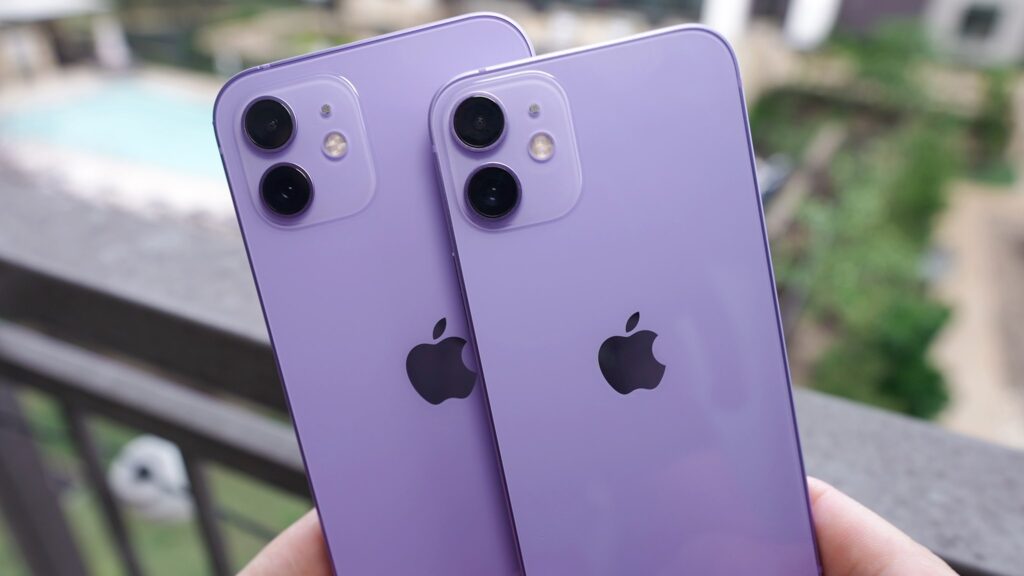
The camera functionality of the Apple iPhone 11 stands out the most, and not simply because of its new Marmite shell. The biggest change between the 2019 model and the iPhone XR is the addition of two lenses on the back: a standard lens and an ultra-wide lens, as well as additional software-based functions like night mode. The lack of low-light photography skills on earlier iPhone models was one of their main knocks. The iPhone 11 models have made an effort to address this, and, in our view, they do a pretty damn excellent job compared to past iPhones. Competing handsets like Google’s Pixel 3 and Huawei’s P30 Pro have been substantially more capable than previous iPhones in terms of night photographs. Apple’s night mode intelligently recognizes when you’re trying to shoot a shot in low light and makes the necessary adjustments. The mode cannot be activated like Pixel’s Night Sight can, nor can the image be edited after the fact—a function we hope may be added in the future, similar to the option to modify the depth in a portrait photo.
Instead, the iPhone 11 can tell whether you’re taking a photo in low light and how much you’re moving the camera by displaying a little icon in the top left corner when the night mode is enabled. You can toggle off night mode by sliding the slider beneath the image on your screen, which also displays a certain number of seconds. The number of seconds on the slider depends on a lot of variables, but the iPhone 11 will recognize whether you’re using a tripod, for instance, and offer you a much longer exposure to get better results. The results from the iPhone 11 are great in favorable lighting, with lots of clarity, brilliant colors, and no noise. The bigger selfie camera is excellent for group selfies, and the super wide angle is terrific for getting a lot more in the photo.
With the iPhone 11, you can still point and shoot and get a respectable output, but there are also a number of settings tucked away in the Slo-Mo, Video, Photo, and Portrait sections that are accessed by swiping up from the panel beneath the image viewer. There are new features here as well on the video front. Up to 4K 60fps is supported, and a new setting called Cinematic Video Stabilization is available for smoother films. The iPhone continues to generate some of the best-looking, most fluid video you’ll find on any smartphone, and all of its performance and capabilities are still more than adequate for the majority of consumers.
The iPhone 12 has the same configuration of cameras as the iPhone 11: a 12-megapixel wide-angle primary camera, a 12-megapixel secondary ultra-wide-angle camera, and a 12-megapixel front camera. The primary camera’s new f/1.6 aperture for enhanced low-light pictures is the only difference in specifications other than generational advancements. On the software side, all three cameras now support Deep Fusion and Night mode, and Dolby Vision HDR video can be recorded at up to 30 frames per second. Better performance and more adaptability in low light are the key advantages. The majority of Apple’s camera techniques operate in the background; for example, Deep Fusion will combine many exposures using what Apple refers to as “computational photography” to create a single, properly exposed frame. Night mode automatically switches on when necessary; it is not a separate setting that you must pick. You will have the exact same experience with the iPhone 12 small, and interestingly, the outcomes are nearly identical on both devices.
Daylight images appeared clear and bright, with colors that were vivid without being oversaturated and respectable quantities of detail, even in far-off objects. Although the resolution is notably worse, the ultra-wide-angle camera does a superb job, and photographs have the same basic tone and little to no distortion at the corners. The depth of field in close-ups seems really realistic. The primary camera of the iPhone 12 appears to excel at reproducing incredibly fine detail in close-up shots, especially when dealing with complicated exposures. Both people and animals can be photographed in portrait mode, and the background is visually reduced. However, it can be difficult at times when locking on a topic, and edge detection struggles with wavy objects like flowers. After snapping the picture, you can change the portrait lighting and backdrop blur effects. Strikingly, taking standard close-up photos is simple and much more flexible in terms of framing, but you don’t get the same lush effect or customization choices.
The iPhone 12 performed remarkably well in low-light photographs, exposing features in landscapes that were completely hidden from the naked eye. This phone was able to capture amazing contrast in landscapes and fine detail in close-ups with almost any ambient light present. The delay is 2-3 seconds by default, but you can increase it to 29 seconds, which is only suggested when using a tripod. We were able to photograph stars on a moonless night as distinct points rather than merely blotches against the night sky. You must use the main iOS Settings app to override the default HDR recording of video. With very minimal jerkiness, it seems fluid and bright in both 1080p and 4K, thanks to the optical stabilization of the primary camera. Both during the day and at night, you may achieve decent results using the wide-angle lens.
Selfies are additionally clear and crisp, and Night Mode enables you to take acceptable pictures even in darkened corners. On paper, the camera configuration of the iPhone 12 mini appears to be fairly identical to that of the iPhone 11, but there are enough changes to warrant the next-gen label. Note that this is the exact same camera array as on the iPhone 12, so choosing the smaller phone won’t cost you anything. A 12MP “ultra-wide” camera with a 120-degree field of view and an f/2.4 aperture is available in addition to a 12MP “regular” wide-angle camera with an f/1.6 aperture. Since there isn’t a specialized camera to perform the hard lifting, your magnified images won’t appear as dazzling as they would on an iPhone 12 Pro or Pro Max with a telephoto sensor.
The cameras on the iPhone 12 mini fared admirably in our tests, placing Apple’s cameras among the best automatic shooters available. According to Apple, the biggest advancement over the previous model is low-light performance, which is largely attributable to the main camera’s aperture decreasing from f/1.8 on the iPhone 11 to f/1.6 here. We confirmed that the camera handled low light conditions admirably. This year, Apple’s Night Mode is compatible with both the rear cameras and the selfie camera. It functions similarly to other manufacturers’ technology in that the iPhone detects a lack of light and requests that you hold the phone still for a variable period of time (depending on how much light is present) so that it can take pictures.
Even Night Mode will struggle if you’re shooting in almost total darkness, but you’ll be amazed at how much the camera can boost the exposure to make a nighttime photo appear to have been taken in the brightness of day. The cameras occasionally feel a little sluggish, but that’s probably because certain images automatically use Apple’s Smart HDR 3 technology. This makes use of artificial intelligence to recognize different components of the scene you’re capturing and then adjusts the exposure to emphasize particular details or regions. The iPhone 12 mini’s video recording capabilities are excellent; in addition to Full HD recording, you can also record in 4K at 24, 30, or 60 frames per second and use slow motion. The introduction of Dolby Vision HDR is a major difference here, and in our tests, we discovered that the quality was noticeably greater than that of the non-HDR clips we shot, with footage seeming more colorful and detailed. Even while on its own, it’s not a compelling enough reason to purchase the iPhone 12 small, it’s a good improvement for people who seek greater video quality.
Performance
When the iPhone 11 was released, Apple already had the fastest CPU in a phone, and the A13 Bionic chip added to that superiority. According to Apple, the A13 chip performs 20 percent quicker than its predecessor in all areas, including CPU, graphics, and machine learning. We used the new iPhone to chop, slash, and double leap the way through the side-scrolling platformer Grimvalor, which ran incredibly well. Even with numerous enemies on the screen, We didn’t detect any lag. We also had fun playing Angry Birds AR since We could get up close and personal with the pigs before launching the slingshot and because We had no stuttering when moving around the level.
On the 3DMark benchmark app, the iPhone 11 lagged below top Android phones in terms of graphical performance. We edited a 4K film in the Adobe Rush program, converted it to 1080p, and then tested real-world performance. Surprisingly, the iPhone 11 finished in just 45 seconds, which is nearly as quickly as the iPhone XR time from the previous year. Even so, the Note 10 Plus’s time of 1:34 still beats that of the Android rivals.
It shouldn’t come as a surprise that the iPhone 12 performed flawlessly in everyday use. Everything felt smooth, from Face ID verification to launching demanding games and toggling between apps. Even mid-range phones don’t get put too much duress these days, yet the A14 Bionic nevertheless absolutely exceeds expectations in terms of responsiveness and smoothness. But with routine use, We could feel the iPhone 12’s back getting a little warm. Although it wasn’t a problem, it was obvious. The rear and metal frame did get pretty warm while the A14 Bionic SoC was being pushed to its maximum in games and tests, which might be uncomfortable for certain individuals for extended periods of time. This might be somewhat reduced with a case.
With the exception of the body feeling a little warm, Call of Duty Mobile and Asphalt 9: Legends performed well. Alto’s Odyssey and Lara Croft Go were excellent casual games. Though you’ll need to bring your own Bluetooth headphones or reuse a headset with a Lightning connector from an older iPhone, you won’t have any trouble finding entertainment. The display is attractive, clear, and bright. Aside from the enormous notch sometimes getting in the way, videos and games look fantastic. One of the primary areas in which the iPhone 12 is a big improvement over its predecessors is the color vibrancy of HDR films. Although the bass is weak, the stereo speakers offer surprisingly full and detailed sound, and even at maximum volume, there is no distortion.
Although the iPhone 12 mini is small, it has plenty of power. The A14 Bionic processor found in Apple’s chipset is also used in the other members of the iPhone 12 family. Even if it isn’t the newest chipset, it is still powerful enough. The A14 Bionic managed to keep up with everything we asked of it, including running graphically intensive games, as we put the chipset through its paces with a variety of multitasking activities. In spite of the fact that it only has 4GB of RAM, which is less than what a lot of other manufacturers offer, we found that the iPhone 12 small had more than enough power to get the job done. The 12 Pro series has 6GB of RAM if you need a little bit more power for advanced video processing or anything similar, but for the majority of users, 4GB is sufficient.
The internal storage for the iPhone 12 small comes in three different sizes: 64GB, 128GB, and 256GB. If you are a power user, you will need to choose the iPhone 12 Pro, which has storage capacities starting at 128GB and going all the way up to 512GB if you need more space on your device. The truth is that 64 gigabytes of storage space on a smartphone is not a lot these days, and the vast majority of users will not take very long to fill up that space with apps, images, music, and other forms of data. It’s likely that you’ll need additional space if you don’t want to occasionally receive the “storage full” notification on your phone. We discovered that after just a week of filling our phones with apps and media, we were getting close to the limit. The iPhone 12 mini comes with iOS 14.2 installed, so you can make use of all the new features of Apple’s mobile operating system, including the App Library and home screen widgets.
READ MORE: Razer Edge 5G Vs Vivo T1 5G: Which One Is Better?
Battery Life
The iPhone 11’s battery performance is remarkable, though. However, over the time we’ve owned and tested the iPhone 11 and its numerous capabilities, we’ve concluded each day on over 40% of the battery. Of course, your usage and what you’re doing greatly influence battery life. It soon runs out if you watch a few movies at maximum volume. Even heavy users should be able to use the iPhone 11 throughout the day and night, which isn’t terrible considering some other flagship handsets from competing firms have trouble getting through a full workday. Although the iPhone 11 is capable of fast charging, the 18W fast charger does not include in the package as it does with the iPhone 11 Pro models. Additionally, it supports wireless charging.
Even while the iPhone 12 has a battery life that is not very impressive, it is still possible to get through a whole day with it and possibly even have some power left over for the next day. You should probably plug this phone in (or attach a MagSafe pad) each night if you spend an hour or two playing games, streaming a lot of music, checking your social media feeds, and shooting a lot of pictures and videos. In our HD video loop test, the iPhone 12 lasted for a respectable 14 hours and 32 minutes, narrowly surpassing the iPhone 12 tiny and trailing the iPhone 12 Pro with a battery of the same capacity. Since Apple no longer includes a charger and customers will utilize multiple adapters with differing output ratings, We were unable to meaningfully test charging speed.
The iPhone 12 mini has a 2227 mAh battery from Apple. The battery life has increased over prior handsets, like with the majority of iPhone models, but it still won’t provide you the longest battery life. The iPhone 12 mini lasted us a whole day on a single charge, but on rare occasions, after a busy day of use, it would run out of power at about 10 o’clock. But despite it being an extremely hectic day, we discovered that on other busy days, the phone would survive until bedtime. The iPhone 12 mini had 22% of its battery left at the end of the day, with moderate to heavy use. That was with the screen on for four hours and twenty minutes, along with a number of background activities, including music playback and notifications.
Again, this will offer a good day’s worth of battery life for an average amount of usage, but if you use your phone continuously throughout the day on mobile networks, you’ll find that this phone will need to be recharged around the middle of the day. These statements are correct based on our tests, and they are reflective of how the battery life differs between the smaller iPhone 12 mini and the bigger iPhone 12. Apple promises that the iPhone 12 mini will last for up to 15 hours of video playback, while the iPhone 12 and iPhone 11 are both capable of 11 hours. With the iPhone 11, Apple has made some minor improvements to its fast-charging technology, which means that you can now take advantage of 20W quick charging. What exactly does that mean? The iPhone 12 small was able to charge from empty to 60% in under 30 minutes, according to our research.
iPhone 11 Vs iPhone 12 Vs iPhone 12 Mini: Quick Results
| Particulars | iPhone 11 | iPhone 12 | iPhone 12 Mini | Which One Is Better? |
| Design | Good | Good | Better | iPhone 12 Mini |
| Display | Better | Better | Good | iPhone 11 And iPhone 12 |
| Performance | Good | Better | Better | iPhone 12 And iPhone 12 Mini |
| Battery | Better | Good | Good | iPhone 11 |
| Camera | Good | Good | Good | Any |
Final Verdict: iPhone 11 Vs iPhone 12 Vs iPhone 12 Mini
In addition to having a very responsive software environment, the Apple iPhone 11 still performs superbly in terms of battery, CPU, and camera performance. If you have the financial ability to do so, purchasing one of the Pro models or one of the other flagship smartphones currently available on the market is a great investment because it will provide you with access to some very remarkable capabilities. However, the iPhone 11 is still an iPhone for the public because it offers amazing value compared to the Pro variants and other top handsets on the market while delivering on all fronts.
Although the iPhone 12 is a reliable and capable phone, it is also incredibly expensive. It is positioned as a premium choice alongside the iPhone 12 small due to its sleek new shell, superb high-resolution OLED screen, and flexible cameras. Personal preference in terms of handling and screen size will determine which sibling you choose, but you should also take the battery life into account. You should also keep in mind that the iPhone 12 Pro costs substantially less and has almost all of the same features if money is not an issue for you or if you take photography and video recording very seriously, the iPhone 12 should be sufficient to meet all of your requirements.
Although the iPhone 12 mini is the most affordable model in the family, it doesn’t seem like a “cheap” iPhone. If you’re looking for a less expensive member of the iPhone 12, choose this model because the specs and user experience are much better than the iPhone SE (2020). Although it may seem obvious, this phone’s most distinctive selling point is its size. This is a great option for you if you’re going to go with an iPhone and you want a smaller smartphone without shelling out the extra money for the most recent iPhone. Additionally, it’s one of the smallest 5G phones currently available on the market.
READ MORE: Redmi A1+ Vs Redmi A1: Which Is The Best?


